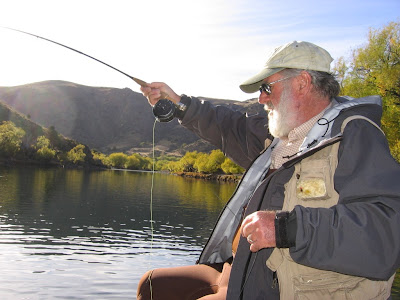Click on photos to enlarge.

About a month ago Marco (my stepdaughter’s husband’s cousin‘s husband; hence family in Chile) called asking if I would like to go fishing with him and a group of friends in Aluminé, Argentina, a long day’s drive, 800 km, from Santiago.

The week would cost around $1000 US, a nice piece of change to a retired professor, but only about 1/3 to 1/5 the going rate in lodges catering to foreigners. And that included everything—7 nights hotel; six days of guides and boats; one day fishing on foot; plus meals, wine, shared gas, car insurance and tolls from Santiago. I said “yes,” or rather “YES!”

So around 5:30 AM on Saturday, April 25 we left
Chilean immigration and customs, Icalma
Hostería Aires del Sur (their photo)
The fishing, strictly catch-and-release, is done from Catarafts, holding two fishermen and a guide who rows facing downstream, usually against the current to slow our drift and position the boat for the rapids. The fishermen cast to the banks, usually 40 to 60 feet away, with fly lines (130 to 200 grain shooting heads, 0X-1X tippets, mostly on 9’, 6 wt. rods, if you want to know) that have fast sinking tip sections 24 feet long followed by 65 feet or so of floating “running line.” That is connected to “backing,” reserve line in case a big fish “runs” and takes your whole fly line out. On the end is a clear leader of 6 to 9 feet attached to a “streamer fly” with a barbless hook. The fly, frequently a “wooly bugger,” may have a head weighted with a brass bead (a “bead head”) or may be unwieghted, carried down by the sinking line.
The fishing, strictly catch-and-release, is done from Catarafts, holding two fishermen and a guide who rows facing downstream, usually against the current to slow our drift and position the boat for the rapids. The fishermen cast to the banks, usually 40 to 60 feet away, with fly lines (130 to 200 grain shooting heads, 0X-1X tippets, mostly on 9’, 6 wt. rods, if you want to know) that have fast sinking tip sections 24 feet long followed by 65 feet or so of floating “running line.” That is connected to “backing,” reserve line in case a big fish “runs” and takes your whole fly line out. On the end is a clear leader of 6 to 9 feet attached to a “streamer fly” with a barbless hook. The fly, frequently a “wooly bugger,” may have a head weighted with a brass bead (a “bead head”) or may be unwieghted, carried down by the sinking line.

OK…. Got the picture?
Once on the water the casting is fast and furious: Pick up the fly; one, two false casts of 30 feet then the cast, shooting another 20 to 30 feet of running line through the guides as the loop unrolls. Splat! on the water (not much delicacy here), then strip-strip-strip puling the fly in by hand fast. If you feel a weigh or pause you strike, hard, to sink the hook in the fish’s mouth. If not, cast again—behind the rock, it’s shallow, strip fast-fast-fast, a strike, fish on!
The fish is strong, can’t be held, he runs out line and goes into the backing (which, at this point, I recall is probably 30 years old, like the reel). But then he turned and I gradually won line back, until the next run, and the next. Finally, he was through. Nico, my guide, jumped out of the boat into (unexpectedly) chest deep water and I brought him to the net.
.
A fine rainbow, released safely. And a happy gringo, with the biggest fly-caught trout of his life.
.
We fished with the guides six days, catching and releasing up to 25 trout each per day. Or at least the Chileans did. With up to 15 years experience fishing the Rio Aluminé with these same guides they were better than us gringos, but we did okay and on the last afternoon I got 10, beating the Chileans. It made no difference to me, but Nico, long-suffering guide for Sid and me, was happy as a clam.
As great as the fishing was, there was more to the experience: food! (see Eating Chilean for more) Each day at about 2:00 we stopped for almuerzo, “lunch,” but more like Sunday dinner. The first guide to arrive built a drift wood fire, and as the others arrived, they set up a table, broke out the tablecloth, plates, silverware, wine glasses, the wine and good whiskey, and we rested while they worked.
.
First came starters: empanadas; eggplant, onions and peppers cooked like ratatouille; strips of kidneys in wine; mushrooms in cream, stacks of filled crêpes or little tarts like in the picture with Marco and José Maria
Then the main course: Argentine beef filet, strip steak or short ribs; stuffed chicken breast; pork roast stuffed with peppers; big fat raviolis in cream; all served with salads and good Chilean wine brought from home.
And then there was dessert, followed by a little more rest.

On our last evening we invited the guides to dinner in the hotel, and arranged to have chivo asado, goat cooked at a wood fire, Argentine style.
Waiting for the goat.
.There was plenty.
.
The trip photo.















